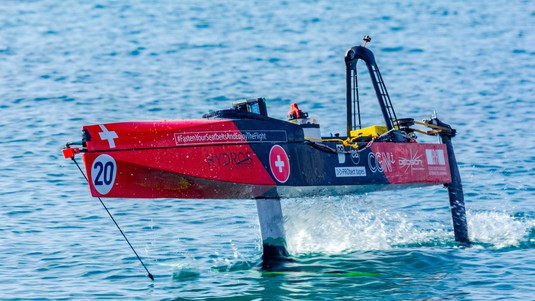European students to race futuristic boat designs in Yverdon

HydroContest EPFL Team's light boat, last year in Saint-Tropez. ©Sébastien Jaffaux
This year, three universities from French-speaking Switzerland – EPFL, HEIA-FR and HEIG-VD – will co-host the sixth annual HydroContest competition, challenging student teams to come up with fast, energy-efficient boat designs.
Around a dozen teams from six European countries are gearing up to compete in the sixth annual HydroContest, which will be held on Lake Neuchâtel in Yverdon-les-Bains this year from 1 to 8 September. This year’s contest is more specifically called HydroContest-X, because it is being organized jointly by three universities in French-speaking Switzerland: EPFL, the Fribourg School of Engineering and Architecture (HEIA-FR) and the Vaud School of Management and Engineering (HEIG-VD). The contest, which is supported every year by the Hydros Foundation, challenges students to design, build and race the most energy-efficient boats possible. The event is free of charge and open to the public.
Each team designs and builds miniature, remote-controlled boats to compete in two contest categories. The two categories are complementary, like Laurel and Hardy – one for thin and light boats, where the aim is to sail fast and far; the other for bigger and heavier ones, which must haul 200 kg of cargo to simulate a freight vessel. Boats in both categories run on batteries provided by the organizer. The event aims to not only enhance students’ education, but also build awareness about the need for cleaner, more energy-efficient shipping vessels and spark ideas for technology in this area.
An asymmetric boat
EPFL students have participated in the contest every year since it was launched. And this year’s team will show up in Yverdon-les-Bains with not two, but three boats. Two of them are from last year’s HydroContest. The first one, which competed in the Mass Transport category, is a hybrid between a catamaran and an airboat that sails on a thin cushion of air. It won the innovation prize last year but was eliminated during the quarterfinals. The second boat, which competed in the Private Boats category, is a twin-foil vessel designed in 2016. This boat proved to be fast but fairly unstable; it came in second place last year behind HEIA-FR.
The third boat – new this year – is designed after a prao, a traditional Indonesian sailboat. It has only one hull and one lateral float, making it asymmetric. “We designed it over the past year, it works, and we’ve tested it several times, yet it still needs to be tweaked,” says Sébastien Jaffaux, head of EPFL’s HydroContest team. “So at this point it’s too early to enter it in the race. But if we get the new foils in time, we’ll run demos on the lake.”
But the students have big plans for next year, when, as part of the Swiss Solar Boat project, they will use their prototypes as test platforms for the 2020 Monaco Solar & Energy Boat Challenge. The boats in that event – another international competition – will measure over six meters long and have a sailor on board.
Follow HydroContest EPFL Team on Facebook: https://fr-fr.facebook.com/HydroEPFLTeam/ and Twitter: @Hydro_EPFL_Team





